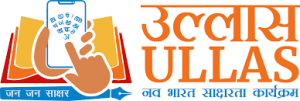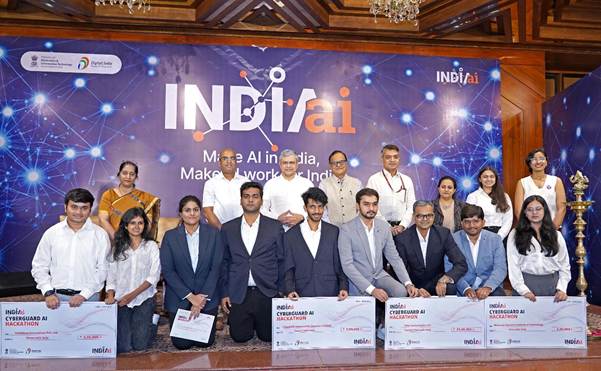ULLAS – Nav Bharat SaakshartaKaryakram and Goa’s Milestone in Literacy

- 02 Jun 2025
In News:
Recently, Goa became the second state in India to achieve full functional literacy under the ULLAS – Nav Bharat SaakshartaKaryakram (New India Literacy Programme), marking a key achievement in India’s goal of attaining full literacy by 2030, as envisioned in the National Education Policy (NEP) 2020.
About ULLAS
- ULLAS stands for Understanding Lifelong Learning for All in Society.
- It is a centrally sponsored scheme implemented by the Ministry of Education from 2022 to 2027.
- Target Group: Adults aged 15 years and above who missed formal schooling.
- Alignment: The scheme is aligned with NEP 2020, emphasizing inclusive and equitable education.
- Implementation Basis: The programme is built on the spirit of volunteerism and Kartavya Bodh (sense of duty).
Five Components of the ULLAS Scheme:
- Foundational Literacy and Numeracy
- Critical Life Skills
- Basic Education
- Vocational Skills Development
- Continuing Education
Digital Outreach
- The ULLAS mobile app facilitates registration of learners and volunteers.
- It also provides access to learning resources through the DIKSHA portal of NCERT.
- So far, over 2.40 crore learners and 41 lakh volunteer teachers have been registered on the app.
- Over 1.77 crore learners have taken the Foundational Literacy and Numeracy Assessment Test (FLNAT).
Goa Achieves Full Literacy
- Declared Fully Literate: On May 30, 2025, during the 39th Goa Statehood Day celebrations at Panaji, Goa was declared fully literate.
- Reported Literacy Rate: As per PLFS 2023–24, Goa had a literacy rate of 93.60%, among the highest in India.
- State Survey Update: A state-led survey confirmed that Goa had crossed the 95% benchmark, qualifying it as fully literate under ULLAS.
Key Factors Behind Goa’s Success
- Adopted a Whole-of-Government approach, involving departments such as:
- Directorate of Panchayats
- Municipal Administration
- Social Welfare
- Planning & Statistics
- Women & Child Development
- Engaged SwayampurnaMitras for grassroots awareness and learning support.
- Played an active role in certification and inclusion of learners into the literacy programme.
- Strong collaboration between SCERT, local administration, school heads, volunteers, and field workers ensured last-mile delivery.
Significance for India
- Goa's achievement underscores the effectiveness of decentralized, people-driven literacy campaigns.
- Demonstrates the potential of tech-enabled platforms, volunteerism, and inter-departmental coordination.
- Sets a model for other states in achieving India’s literacy goal by 2030.
- Reinforces the broader national vision of “Jan-Jan Saakshar” and a Viksit Bharat.
Kawal Tiger Reserve and KumramBheem Conservation Reserve

- 02 Jun 2025
In News:
In a recent development, the Telangana government has designated the tiger corridor connecting the Kawal Tiger Reserve (Telangana) with the Tadoba-Andhari Tiger Reserve (Maharashtra) as the KumramBheem Conservation Reserve, under Section 36(A) of the Wildlife Protection Act, 1972. This move is aimed at preserving critical wildlife corridors in the Central Indian Landscape.
Kawal Tiger Reserve:
- Location: Situated in Telangana, along the Godavari River, forming part of the Deccan Peninsula – Central Highlands.
- Biogeographic Zone: Lies at the southern tip of the Central Indian Tiger Landscape.
- Connectivity: Links with Tadoba-Andhari (Maharashtra), Indravati (Chhattisgarh), and other reserves like Tipeshwar, Chaprala, and Kanhargaon.
- Vegetation Type: Southern Tropical Dry Deciduous Forests.
- Flora: Dominated by teak, bamboo, and species like Anogeissuslatifolia, Terminalia arjuna, Boswellia serrata, etc.
- Fauna: Hosts tiger, leopard, nilgai, chinkara, sambar, blackbuck, wild dog, wolf, and jungle cat.
KumramBheem Conservation Reserve: Newly Notified Area
- Legal Basis: Declared under Section 36(A), Wildlife Protection Act, 1972, which allows states to notify government-owned land adjacent to or connecting protected areas as conservation reserves.
- Total Area: 1,492.88 sq km (149,288.48 hectares)
- District &Mandals Covered: Spread across KumramBheemAsifabad district, covering parts of Kerameri, Wankidi, Asifabad, Sirpur, Koutala, Bejjur, Kagaznagar, Rebbana, Dahegaon, and Tiryanimandals.
- Forest Blocks Included: 78 blocks including Garlapet, Ada, Manikgarh East & West, Danora, Gudem, Bejjur, Kadamba, and Girali.
Ecological Significance
- Tiger Movement: Over the last decade, more than 45 unique tigers (mostly transient) have been documented in this corridor through camera trapping and surveys.
- Breeding Evidence: Since 2015, 17 tiger cubs born from 3 tigresses have been recorded. The 2022 Tiger Census confirmed 4 adult tigers and 3 cubs in the area.
- Leopard Presence: 8 leopards were recorded during the All India Leopard Estimation, 2022.
- Other Carnivores: Includes sloth bear, hyena, wild dog, wolf, honey badger, and jungle cat.
- Herbivore Diversity: Rich prey base such as gaur, sambar, nilgai, chital, muntjac, four-horned antelope, and Indian gazelle.
- Avifauna: Home to 240+ bird species, including rare species like the Malabar Pied Hornbill and Long-billed Vulture, the latter using the reserve as a nesting site.
- Elephant Movement: Occasional elephant presence has also been reported.
Governance
A Conservation Reserve Management Committee has been established. Members include:
- District Forest Officer (DFO) of KumramBheemAsifabad (Convenor)
- Sarpanches of local panchayats (e.g., Karji, Motlaguda, Murliguda)
- Representatives from NGOs like Hyderabad Tiger Conservation Society, WWF-India, and Wildlife Conservation Trust
- Officials from Veterinary, Agriculture, and Forest Divisions
Ghatampur Thermal Power Project
- 02 Jun 2025
In News:
Prime Minister Narendra Modi recently dedicated Unit-1 (660 MW) of the Ghatampur Thermal Power Project, located in Kanpur Nagar, Uttar Pradesh, marking a major step forward in India’s thermal power capacity and energy security goals.
Project Overview
- Location: Ghatampur, Kanpur Nagar District, Uttar Pradesh
- Implementing Agency: Neyveli Uttar Pradesh Power Ltd (NUPPL) — a joint venture between
- NLC India Ltd (51% share)
- Uttar Pradesh Rajya Vidyut Utpadan Nigam Ltd (UPRVUNL) (49% share)
- Total Capacity: 3 units × 660 MW = 1,980 MW
- Project Cost: ?21,780.94 crore
Commissioning Timeline
- Unit-1 (660 MW): Commissioned in December 2024, dedicated in May 2025
- Remaining Units: Expected to be operational by December 2025
Power Distribution Agreement
- Uttar Pradesh: Receives 75.12% (1,487.28 MW) of the total power
- Assam: Allocated 24.88% (492.72 MW), subject to transfer of 20% equity from UPRVUNL to Assam Government
Technological and Environmental Features
- Efficient Supercritical Technology:Utilizes supercritical boilers with 88.81% efficiency, reducing fuel usage and emissions.
- Zero Liquid Discharge (ZLD):Ensures no industrial wastewater release, protecting surrounding land and water bodies.
- Air Pollution Control:Equipped with modern pollution mitigation systems:
- Selective Catalytic Reduction (SCR) – Controls NOx emissions
- Flue Gas Desulphurization (FGD) – Reduces SOx emissions
- Continuous Emission Monitoring System (CEMS) and Ambient Air Quality Monitoring Stations (AAQMS) – Ensure real-time pollution tracking
- Water Conservation Measures:
- 288 km of canal lining saves approx. 195 million litres/day
- Raw water storage capacity of 46 lakh cubic meters
Fuel Security
- The plant sources coal from its own captive mine, producing 9 million tonnes annually.
- It maintains a 30-day coal stockpile, equivalent to 10.165 lakh tonnes, ensuring uninterrupted operation.
IndiaAI Mission

- 02 Jun 2025
In News:
India has taken a major step toward self-reliance in Artificial Intelligence with the expansion of its national AI compute infrastructure and the selection of three new startups to build indigenous foundation models under the IndiaAI Mission.
Key Highlights
- Compute Infrastructure Boost:India’s total GPU capacity has now surpassed 34,000 units, up from the initial 10,000-target. A fresh addition of 15,916 GPUs to the existing 18,417 empanelled GPUs brings the total to 34,333 GPUs, now available through the IndiaAI Compute Portal (operational since March 2025).
- Subsidised Access:These GPUs are made available at a subsidised rate of ?67/hour, well below the global average of ?115/hour. This has been made possible through private sector empanelment instead of government-built data centres. Service providers receive up to 40% capital subsidy, enabling rapid infrastructure rollout.
- Empanelled Providers:Seven private companies were empanelled for compute provisioning:
- Cyfuture India Pvt. Ltd.
- Ishan Infotech Ltd.
- Locuz Enterprise Solutions Ltd.
- Netmagic IT Services Pvt. Ltd.
- Sify Digital Services Ltd.
- Vensysco Technologies Ltd.
- Yotta Data Services Pvt. Ltd.
Foundation Model Development
Under the IndiaAI Foundation Model initiative, three new startups have joined Sarvam AI (selected earlier in April 2025) to build India-specific Large Language Models (LLMs):
- Soket AI: Will develop a 120-billion parameter open-source model focused on Indian languages and use cases in defence, healthcare, and education.
- Gnani AI: Building a 14-billion parameter Voice AI model for real-time, multilingual speech recognition and reasoning.
- Gan AI: Developing a 70-billion parameter multilingual TTS (text-to-speech) model aiming for "superhuman" capabilities surpassing global benchmarks.
- Sarvam AI: Previously selected to create a 120-billion parameter Sovereign AI model, following the release of Sarvam-1 (2B parameters) and Sarvam-M (24B parameters).
These foundation models will be trained on Indian datasets and tailored for governance, public service delivery, and regional language support.
AI Kosh& Innovation Initiatives
- AI Kosh: A public dataset platform with 367 datasets uploaded, enabling research and model training using India-relevant data.
- IndiaAI I4C CyberGuard Hackathon: In collaboration with the Ministry of Home Affairs, AI models were developed for identifying cybercrime patterns from complex inputs like handwritten FIRs and audio calls on the National Cyber Crime Reporting Portal.
- Startup Innovation & Skill Development: Funding support, AI labs in Tier-II cities, and talent development programs are part of a broader push to promote innovation and reverse brain drain.
About IndiaAI Mission
- Launched by: Ministry of Electronics & Information Technology (MeitY)
- Cabinet Approval: March 2024 with a budget of over ?10,000 crore
- Objectives:
- Develop indigenous AI capabilities and infrastructure
- Democratize AI access for governance, startups, and citizens
- Promote ethical and safe AI use
- Position India among the global AI leaders
India Develops its first indigenous Mechanical Thrombectomy Device for Stroke Treatment
- 02 Jun 2025
In News:
In a significant milestone for India’s medical technology sector, the Technology Development Board (TDB) under the Department of Science and Technology (DST) has extended support for the development of the country’s first indigenously manufactured mechanical thrombectomy device for the treatment of acute ischemic stroke.
What is a Mechanical Thrombectomy Device?
The device is a minimally invasive medical tool designed to treat acute ischemic stroke, which occurs due to a blockage in a large blood vessel in the brain. Unlike conventional thrombolytic drugs that dissolve clots chemically, this device physically extracts the clot, thereby restoring blood flow swiftly and reducing the risk of severe brain damage or paralysis.
Development and Manufacturing
This pathbreaking innovation was developed by S3V Vascular Technologies Ltd, based in Mysuru, with financial backing from the TDB. The manufacturing takes place at an advanced, high-precision production facility within the Medical Devices Park in Oragadam, Tamil Nadu.
Key Features and Technological Highlights
- Indigenous Design: S3V is the first Indian company to conceptualize and produce stroke-intervention tools such as microcatheters, aspiration catheters, guidewires, and stent retrievers.
- R&D and Patents: The company has filed multiple patents, particularly for innovations in clot retriever head design and advanced catheter structures.
- Training and Capacity Building: A simulator-based training program has been initiated to train young medical professionals, with a focus on outreach in Tier-II cities.
- Global Compliance: The device aims to meet CE and USFDA standards, paving the way for international exports and aligning with global quality benchmarks.
Significance for India
- Reduces Import Dependency: The device addresses India’s reliance on expensive, imported stroke-care equipment.
- Cost-Effective Healthcare: By making stroke treatment more affordable, it enhances access to quality care for economically weaker sections.
- Supports Public Health Initiatives: It is expected to be integrated into government schemes like Ayushman Bharat, strengthening the country’s universal healthcare mission.
- Boosts MedTech Ecosystem: This innovation is a major stride in positioning India as a global player in the high-end medical devices sector.
